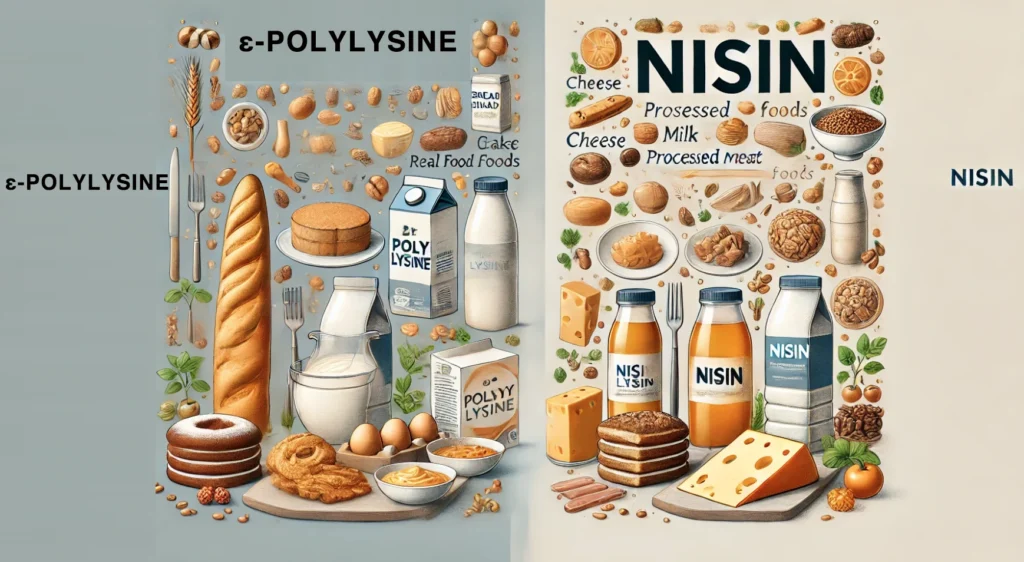
E-Polylysine and Nisin are both natural antimicrobial peptides widely used as food preservatives. However, they have significant differences in their structure, antimicrobial spectrum, stability, and applications. Below is a professional, research-based comparison to help businesses and manufacturers understand when to choose E-Polylysine over Nisin and vice versa.
1. Source & Production Process
| Feature | E-Polylysine | Nisin |
|---|---|---|
| Produced by | Streptomyces albulus (a soil-based bacteria) | Lactococcus lactis (a lactic acid bacterium) |
| Fermentation Type | Alkaline fermentation | Acidic fermentation |
| Extraction Process | Purified from bacterial culture | Extracted from dairy fermentation |
- Key Difference:
- E-Polylysine is derived from Streptomyces bacteria, whereas Nisin originates from lactic acid bacteria.
- E-Polylysine is produced in an alkaline environment, whereas Nisin is produced in acidic conditions.
2. Chemical Structure & Mechanism of Action
| Feature | E-Polylysine | Nisin |
|---|---|---|
| Chemical Type | Homopolymer of L-Lysine (a chain of amino acids) | Peptide composed of 34 amino acids |
| Molecular Weight | ~4,000 – 5,000 Da | ~3,500 Da |
| Charge | Strongly cationic (positively charged) | Less cationic than E-Polylysine |
| Mode of Action | Disrupts bacterial cell membranes, leading to cell death | Binds to lipid II, preventing bacterial cell wall synthesis |
| Solubility | Water-soluble, stable in acidic & neutral pH | Acid-soluble, less stable at neutral pH |
- Key Difference:
- E-Polylysine acts by disrupting bacterial membranes, making it effective against Gram-positive & some Gram-negative bacteria.
- Nisin targets bacterial cell wall synthesis, making it mainly effective against Gram-positive bacteria (not Gram-negative).
3. Antimicrobial Spectrum & Stability
| Feature | E-Polylysine | Nisin |
|---|---|---|
| Effective Against | Gram-positive & Gram-negative bacteria, molds, yeasts | Mostly Gram-positive bacteria |
| Heat Stability | Highly stable (withstands 120°C for 30 min) | Moderate stability (degrades above 100°C) |
| pH Stability | Effective from pH 2.5 – 9.0 | Effective from pH 2.5 – 6.5 |
| Synergistic Effects | Works well with Nisin, organic acids, chitosan | Works well with E-Polylysine, EDTA, essential oils |
- Key Difference:
- E-Polylysine has a broader antimicrobial spectrum, working against both Gram-positive & some Gram-negative bacteria, yeasts, and molds.
- Nisin is more specific to Gram-positive bacteria, making it effective in dairy and meat applications where Gram-positive pathogens like Listeria and Clostridium are a concern.
- E-Polylysine is more heat-stable and works in a broader pH range, making it better for high-temperature processing.
4. Applications & Best Uses
| Feature | E-Polylysine | Nisin |
|---|---|---|
| Best for | High-fat, high-protein foods, emulsions, bakery, beverages | Dairy, meats, low-pH foods, canned foods |
| Dairy | Less commonly used | Very effective (cheese, milk, yogurt) |
| Meat & Poultry | Suitable for meat & plant-based meat | Best for meat and poultry preservation |
| Beverages | Used in juices, soft drinks | Less effective in neutral pH beverages |
| Bakery | Prevents mold in bread and cakes | Less effective |
| Plant-Based Foods | Used in plant-based dairy and meat | Limited use in plant-based applications |
- Key Difference:
- Nisin is best for dairy & meat applications, as it is highly effective against Listeria and Clostridium botulinum.
- E-Polylysine is better for processed foods, plant-based products, and beverages, as it works well in neutral and slightly alkaline conditions.
5. Regulatory Approvals & Safety
| Feature | E-Polylysine | Nisin |
|---|---|---|
| GRAS (Generally Recognized as Safe)? | ✅ Yes | ✅ Yes |
| E-Number (EU Approved)? | E239 | E234 |
| Approved by FDA, EFSA, WHO? | ✅ Yes | ✅ Yes |
| Allergen-Free? | ✅ Yes | ❌ No (dairy-based origin) |
| Vegan-Friendly? | ✅ Yes | ❌ No |
- Key Difference:
- E-Polylysine is suitable for vegan and allergen-free formulations, making it a great choice for plant-based and dairy-free products.
- Nisin is derived from dairy fermentation, which may not be suitable for some vegan or dairy-free formulations.
6. Cost & Economic Considerations
| Feature | E-Polylysine | Nisin |
|---|---|---|
| Production Cost | Higher due to polymer complexity | Lower due to simpler peptide synthesis |
| Usage Level | 10 – 15 ppm | 5 – 25 ppm |
| Shelf Life | 2 years | 2 years |
- Key Difference:
- E-Polylysine is generally more expensive than Nisin but requires lower doses in certain applications.
- Nisin is cost-effective for dairy & meat industries but has limitations in neutral/alkaline foods.
Which One Should You Choose?
✅ Choose E-Polylysine if:
✔ You need broad-spectrum antimicrobial activity, including against Gram-negative bacteria, yeasts, and molds.
✔ Your product is neutral or slightly alkaline (pH 6.5 – 9.0), such as bakery, plant-based foods, and beverages.
✔ You require vegan, allergen-free, and dairy-free preservation.
✔ Your product undergoes high-temperature processing (above 100°C).
✅ Choose Nisin if:
✔ Your main concern is Gram-positive pathogens like Listeria and Clostridium.
✔ Your product is acidic (pH 2.5 – 6.5), such as dairy, meat, and canned foods.
✔ You need a cost-effective preservative for meat, cheese, and dairy applications.
Conclusion: E-Polylysine vs. Nisin – Which is Better?
- E-Polylysine is more versatile, working in a wider pH range and targeting more types of microbes.
- Nisin is highly effective against Gram-positive bacteria, making it the gold standard in dairy and meat preservation.
- For best results, they can be used together, offering synergistic antimicrobial effects to enhance food safety.
At Chibio Biotech, we offer high-quality E-Polylysine and Nisin for food, pharmaceutical, and cosmetic applications.
📩 Contact us now at sales@chibiotech.com for bulk inquiries and customized solutions!

